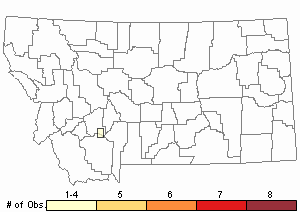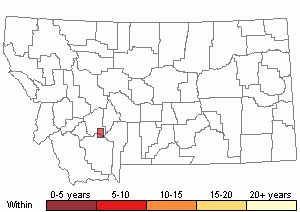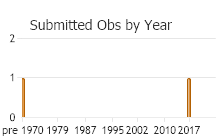View in other NatureServe Network Field Guides
NatureServe
Montana
Utah
Wyoming
Idaho
Wisconsin
British Columbia
South Carolina
Yukon
California
New York
A Cave Obligate Harvestman - Sclerobunus cavicolus
Other Names:
Cyptobonus cavicolens
General Description
Originally named Cyptobunus cavicolus and recognized to be closely related to non cave-dwelling Sclerobunus species (Banks 1905). The full name has been misspelled Cyptobonus cavicolens (Nicholas 1960), and the genus as Cryptobunus (Peck 1998). The most recent revision transfers C. cavicolus (and all other members of Cyptobunus) to the genus Sclerobunus, using the revised name Sclerobunus cavicolens (Derkarabetian and Hedin 2014), a name in earlier use and also misspelled Sclerobonus cavicolens (Nicholas 1960).
[Description from Banks 1905; Derkarabetian and Hedin 2014] S. cavicolens group (=Cyptobunus): Penis with lateral plates extending dorsally into fan-shaped projections, ventral plate compressed dorsoventrally; anterior margin of scute without tubercles on shoulders; found in isolated caves in Montana, Nevada, and Utah.
For S. cavicolens: Male body length 1.8-2.4 mm, scute length 1.58-1.68 mm, greatest width of anterior scute 1.06-1.09 mm, LII (2nd leg) total length 8.87-8.95 mm; female body length about 2.2 mm, scute length 1.67 mm, greatest width of anterior scute 1.01 mm, LII (2nd leg) total length about 8.38 mm. Integument yellow with very faint black pigment; pedipalpal femur with 6 ventral spine-bearing turbercles; pedipalpal tibia with 4 large retrolateral spines; eye tubercle rather large, not very high, rounded, with two large black eyespots above.
Phenology
No information. Adults probably active throughout the year, collected in late February and early July; juveniles collected in early July (Derkarabetian and Hedin 2014).
Diagnostic Characteristics
"Compared to other species in the S. cavicolens group, S. cavicolens is less troglomorphic, with present but highly reduced lateral prongs on the hind claws. Diagnosed based on small body size (scute length <1.7 mm), shorter legs (LII <9 mm), and only 4 spines on pedipalpal tibia" (Derkarabetian and Hedin 2014:12).
Species Range
Montana Range
Range Descriptions

 Native
Native
Range Comments
Endemic to Lewis and Clark Caverns, Jefferson County, Montana (Banks 1905; Nicholas 1960; Derkarabetian and Hedin 2014). Within the cave, reported from at least the Big Spring Room, Cathedral Room, Paradise Room (Derkarabetian and Hedin 2014).
Observations in Montana Natural Heritage Program Database
Number of Observations: 4
(Click on the following maps and charts to see full sized version)
Map Help and Descriptions
Relative Density

Recency



 (Observations spanning multiple months or years are excluded from time charts)
(Observations spanning multiple months or years are excluded from time charts)
Migration
Non-migratory, movements within Lewis and Clark Caverns not described.
Habitat
A limestone cave obligate. Within the cave, reported on cave walls and at depths to at least 58 m (Banks 1905; Nicholas 1960; Derkarabetian and Hedin 2014).
Food Habits
Not described.
Reproductive Characteristics
Not described. Adult males and females collected in late February and early July, juveniles in early July (Derkarabetian and Hedin 2014).
Stewardship Responsibility
References
- Additional ReferencesLegend:
 View Online Publication
View Online Publication
Do you know of a citation we're missing? Banks, N. 1905. A new genus and species of Phalangida. Entomological News 16:251-253.
Banks, N. 1905. A new genus and species of Phalangida. Entomological News 16:251-253. Derkarabetian, S. and M. Hedin. 2014. Integrative taxonomy and species delimitation in harvestmen: a revision of the western North American genus Sclerobunus (Opiliones: Lanitores: Travunioidea). PLoS ONE 9(8):1-25.
Derkarabetian, S. and M. Hedin. 2014. Integrative taxonomy and species delimitation in harvestmen: a revision of the western North American genus Sclerobunus (Opiliones: Lanitores: Travunioidea). PLoS ONE 9(8):1-25. Nicholas, G. 1960. Checklist of macroscopic troglobitic organisms of the United States. American Midland Naturalist. 64:123-160.
Nicholas, G. 1960. Checklist of macroscopic troglobitic organisms of the United States. American Midland Naturalist. 64:123-160. Peck, S.B. 1998. A summary of diversity and distribution of the obligate cave-inhabiting faunas of the United States and Canada. Journal of Cave and Karst Studies 60:18-26.
Peck, S.B. 1998. A summary of diversity and distribution of the obligate cave-inhabiting faunas of the United States and Canada. Journal of Cave and Karst Studies 60:18-26.
- Web Search Engines for Articles on "A Cave Obligate Harvestman"
- Additional Sources of Information Related to "Spiders"





